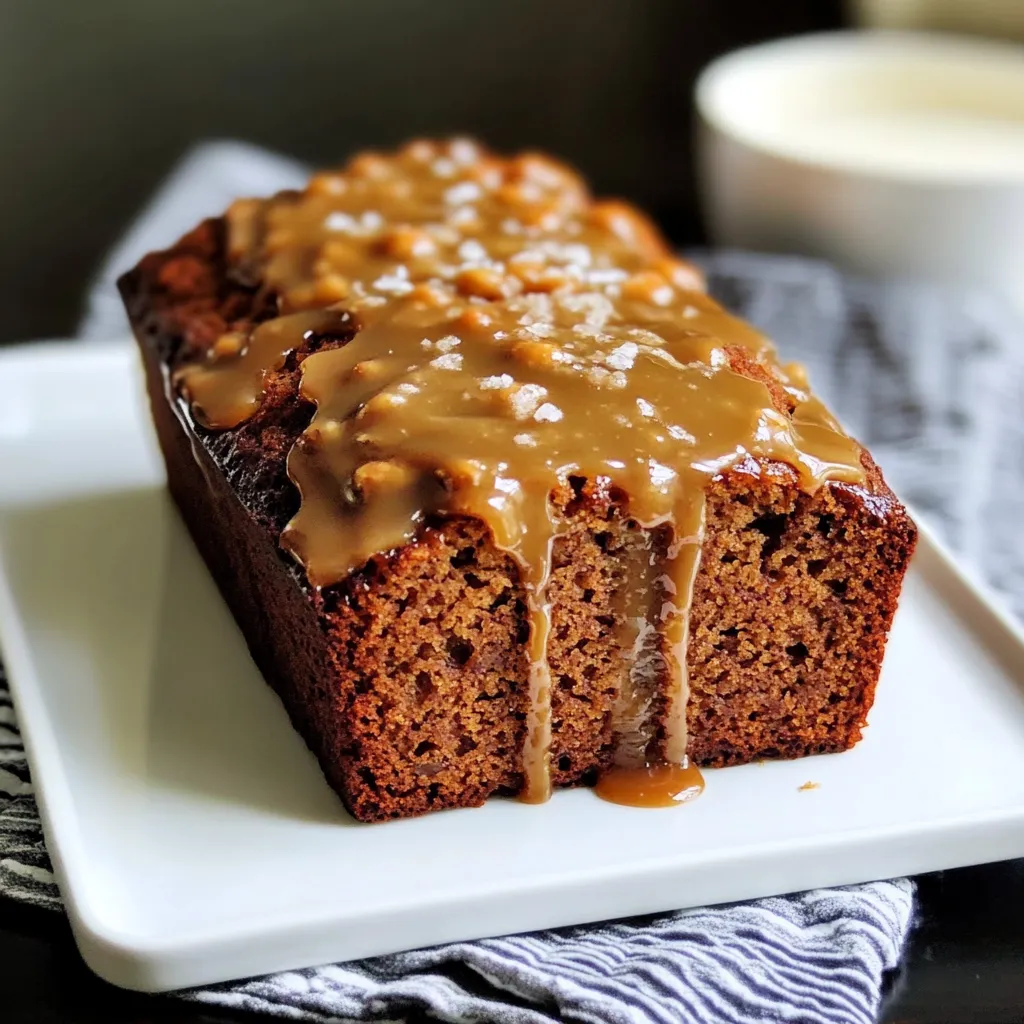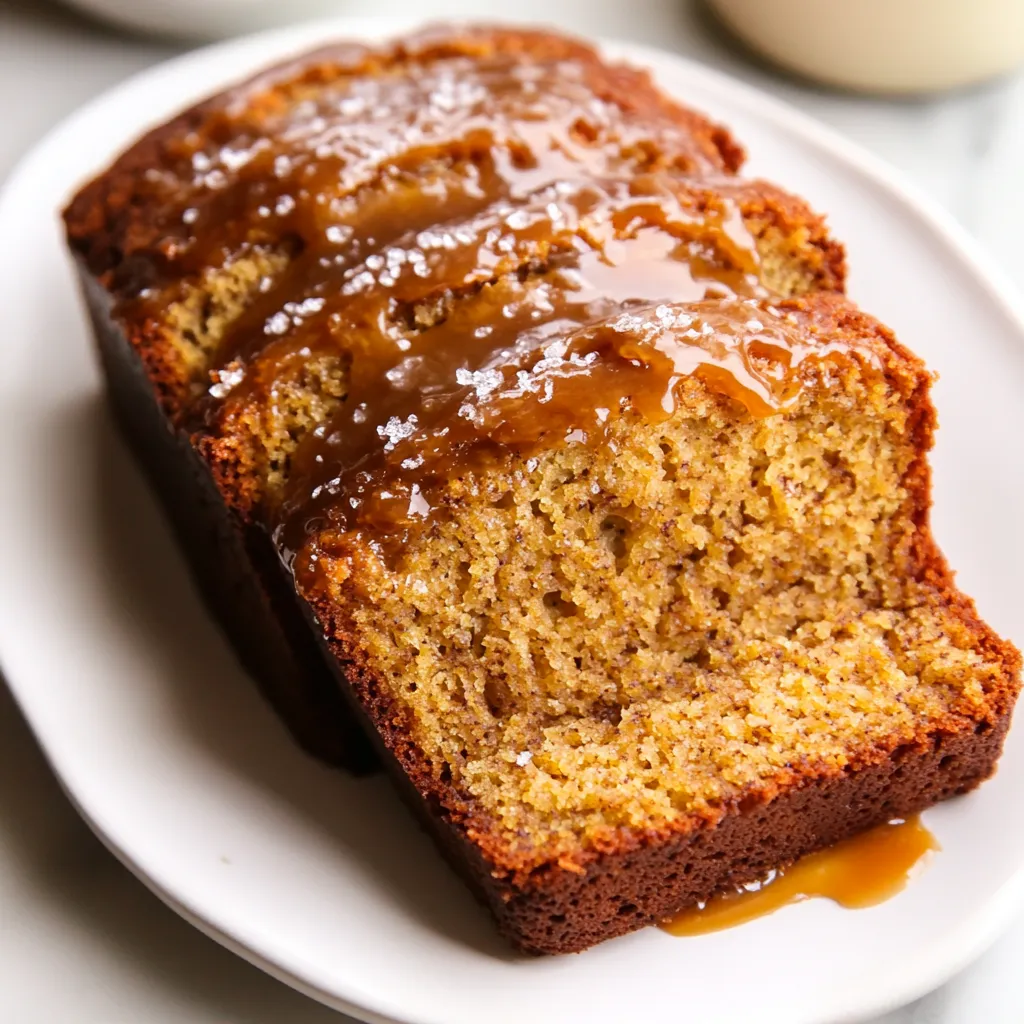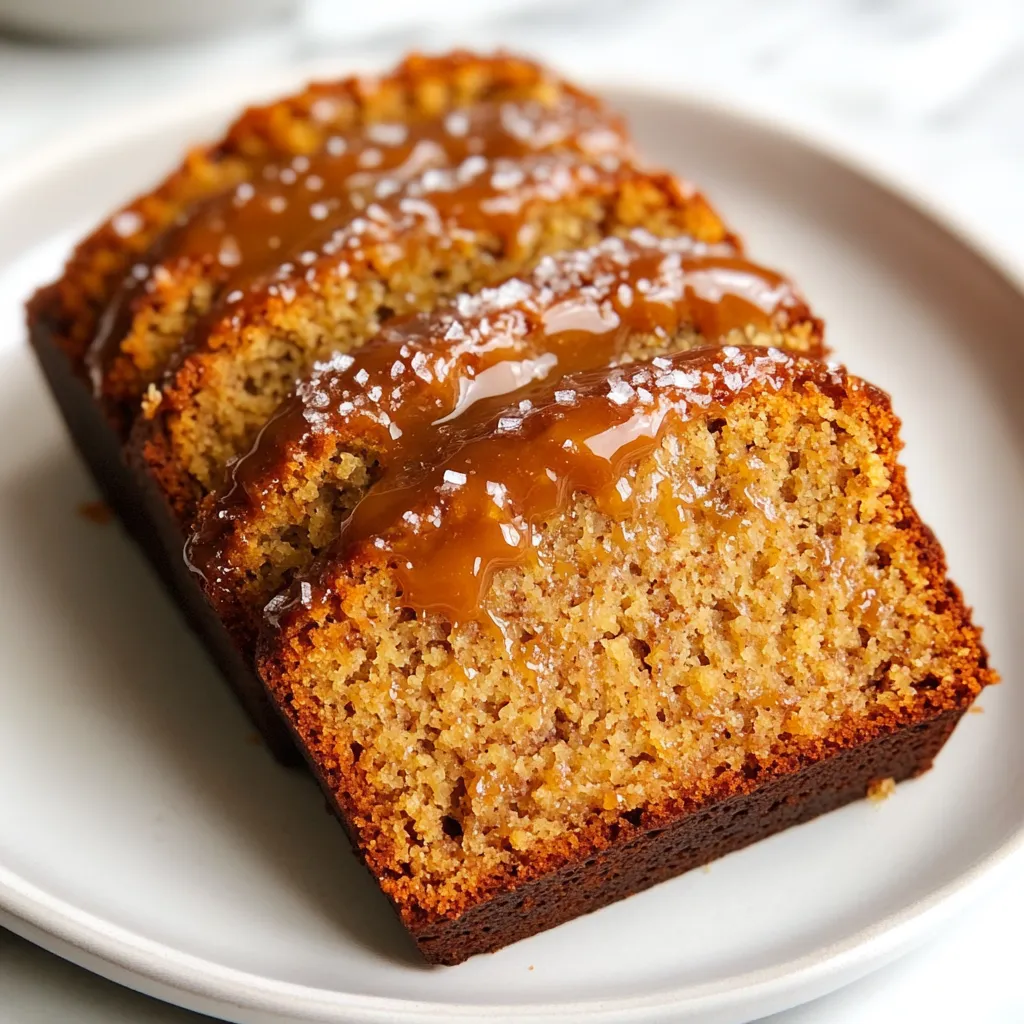 Pin it
Pin it
This salted caramel banana bread transforms overripe bananas into a decadent treat that balances sweet caramel with a hint of salt. The moist, cinnamon-spiced loaf gets elevated with a luscious brown sugar glaze that creates an irresistible finish.
I first made this recipe when I had a bunch of spotty bananas and wanted something more special than basic banana bread. Now it's become my signature dessert for potlucks and family gatherings where people always ask for the recipe.
Ingredients
- All purpose flour: Provides the perfect structure without being too heavy
- Baking soda: Ensures a proper rise and tender crumb
- Ground cinnamon: Adds warmth that complements the banana flavor
- Brown sugar: Contains molasses which deepens the caramel notes
- Unsalted butter: Gives richness and allows you to control the salt level
- Eggs: Bind everything together while adding moisture
- Sour cream: Creates incredible tenderness in the bread
- Very ripe bananas: With brown spots offer the strongest flavor
- Vanilla extract: Enhances all the other flavors
- Heavy cream: Creates a silky texture in the glaze
- Kosher salt: Balances the sweetness with its clean flavor
Step-by-Step Instructions
- Preheat and Prepare:
- Set your oven to 350°F and prepare your loaf pan. I recommend lining with parchment paper with overhang on the sides for easy removal. A light spray of cooking oil ensures nothing sticks.
- Mix Dry Ingredients:
- Whisk together the flour, baking soda, cinnamon, and salt thoroughly. This even distribution prevents any bitter baking soda pockets in your finished bread. Sifting adds extra air for a lighter texture.
- Create Creamy Base:
- Beat the butter and brown sugar for at least 3 minutes until pale and fluffy. This incorporates air and creates the foundation for a tender crumb. The butter must be truly room temperature for proper creaming.
- Incorporate Wet Elements:
- Add eggs one at a time, fully incorporating each before adding the next. Then mix in sour cream, mashed bananas, and vanilla. The mixture might look slightly curdled but this is normal.
- Combine Mixtures:
- Using a rubber spatula, gently fold the dry ingredients into the wet mixture just until no flour streaks remain. Overmixing develops gluten which makes tough bread, so use a light hand with about 10 to 12 folding motions.
- Bake to Perfection:
- Pour the thick batter into your prepared pan, smoothing the top. Bake in the center rack of your oven for 55 to 60 minutes. The bread is done when a toothpick inserted in the center comes out with just a few moist crumbs.
 Pin it
Pin it
The salted caramel element transforms what could be an ordinary banana bread into something truly special. I discovered this accidentally when I was trying to use up some leftover caramel sauce and drizzled it over banana bread. The combination was so magical that I developed this proper recipe with the glaze built right in.
Banana Selection Matters
Banana bread works best with very ripe bananas that have developed black spots all over the peel. These bananas are sweeter, softer, and have a more concentrated flavor. If your bananas aren't ripe enough, you can quickly ripen them by placing them in a paper bag with an apple for 24 hours, or bake them in their peels at 300°F for about 15 minutes until blackened.
Make Ahead Options
This banana bread actually improves with time as the flavors meld together. You can bake the bread up to two days ahead and add the glaze just before serving. Store the unglazed bread tightly wrapped at room temperature. The glazed bread should be refrigerated to maintain the best texture of the caramel topping. You can also freeze individual slices by wrapping them tightly in plastic wrap then aluminum foil for up to three months.
Perfect Glaze Technique
The key to a professional looking glaze is timing. If you pour it while too hot, it will soak into the bread rather than sitting on top. If it cools too much, it won't spread properly. Wait until the glaze reaches a honey like consistency after about 5 minutes of cooling. Pour it in the center of the bread and let it naturally flow toward the edges, using a spatula to guide it if needed.
 Pin it
Pin it
This dessert is an enchanting way to elevate simple bananas—perfect for potlucks or special family occasions.
Frequently Asked Questions
- → How do I know when my bananas are ripe enough for this bread?
The best bananas for this bread are very ripe with plenty of brown spots or even mostly brown peels. They should feel soft to the touch and smell sweet. Overripe bananas are perfect as they're at their sweetest and will mash easily, contributing to the moisture and flavor of your bread.
- → Can I make this banana bread without the salted caramel glaze?
Absolutely! The banana bread base is delicious on its own. If you prefer, you can enjoy it plain or substitute with a simple cream cheese frosting or a dusting of powdered sugar. However, the salted caramel glaze does add a unique flavor dimension that complements the banana perfectly.
- → How should I store this bread to keep it fresh?
Once completely cooled, store the glazed banana bread in an airtight container at room temperature for up to 3 days, or refrigerate for up to a week. The glaze will set but remain slightly sticky. You can also freeze unglazed bread tightly wrapped in plastic wrap and aluminum foil for up to 3 months, then add fresh glaze after thawing.
- → Why did my banana bread sink in the middle?
A sunken middle usually indicates the bread is underbaked or the oven temperature was too high. Ensure your oven is properly calibrated and use the toothpick test—it should come out clean or with a few moist crumbs. Also, avoid opening the oven door during the first 30 minutes of baking, as temperature fluctuations can cause sinking.
- → Can I add nuts or chocolate chips to this recipe?
Definitely! Chopped walnuts, pecans, or chocolate chips make excellent additions. Fold in about 1/2 to 3/4 cup of your preferred mix-ins after combining the wet and dry ingredients. For an extra indulgent version, try adding toffee bits to complement the salted caramel flavors.
- → What's the secret to getting a smooth caramel glaze?
The key to a smooth glaze is proper timing and temperature. Make sure to whisk continuously while the sugar and butter melt to prevent crystallization. Allow the glaze to cool slightly before adding the powdered sugar to avoid lumps. If your glaze does develop lumps, gently reheat it while whisking, or pass it through a fine-mesh sieve.
